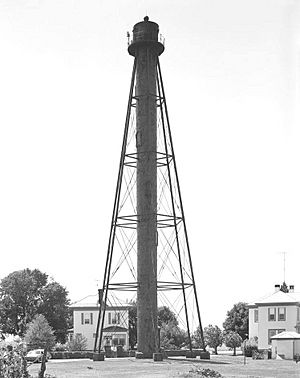Liston Range Rear Light facts for kids
 |
|
| Location | Delaware River, Delaware |
|---|---|
| Coordinates | 39°31′25.7″N 75°38′22.6″W / 39.523806°N 75.639611°W |
| Year first constructed | 1906 |
| Year first lit | 1877 |
| Automated | 1976 |
| Tower shape | Pyramidal Skeletal Tower with cylinder |
| Height | 120 feet (37 m) |
| Original lens | Second order Fresnel lens |
The Liston Range Rear Lighthouse is a tall lighthouse located in Delaware, United States. It stands proudly on the banks of the Delaware River. This impressive tower is 120 feet (37 m) (about 36.5 meters) tall. It is made of wrought iron and was built by the Kellogg Bridge Company.
The lighthouse was first built in 1876–1877. It was originally located a few miles east of where it stands today. In 1906, the entire structure was moved to its current spot. Because of its importance, the Liston Range Rear Lighthouse was added to the National Register of Historic Places in 1978. It is the tallest lighthouse in all of Delaware.
Contents
What is a Range Light?
The Liston Range Rear Light does not work alone. It is part of a special pair of lights called a "range light" system. When a ship's captain lines up these two lights, it tells them they are on the correct path. This helps ships navigate safely along the river.
How the Liston Range Works
The Liston Range Rear Light works with the Liston Range Front Light. Together, they form the Liston Range. The front light is closer to the ship and lower to the ground. The rear light, like the Liston Range Rear Light, is much taller. When a ship is on the right course, the two lights appear stacked one above the other. This simple visual guide helps ships stay in the safe channel.
More About the Liston Range Lights
The Liston Rear Range Light was once part of a bigger group of four lights. This group was known as Liston's Tree Range. Two of these lights were in New Jersey, forming the Finn's Point Range Lights. The other two, in Delaware, became the Port Penn Range Lights.
The "front" lights were usually small, wooden buildings. The "rear" lights, like the Liston Range Rear Light, were tall, open towers made of wrought iron. The two rear lights were very similar. However, the Port Penn rear light was 30 feet (9.1 m) (about 9 meters) taller than the Liston Rear Light.
Inside the Lighthouse Tower
The Liston Range Rear Lighthouse has a unique design. It is a tapering tower, meaning it gets narrower towards the top. Inside this open structure, there is a cylindrical stair tower. This cylinder is 8 feet (2.4 m) (about 2.4 meters) wide. It goes all the way up to the lantern room at the top.
The cylinder is made of thick metal plates that overlap and interlock. At the bottom, there is a small entrance vestibule made of iron plates. Inside, a curved door used to slide open. The cylinder's interior is lined with wood. A spiral staircase winds its way up around a central column. Near the very top, there is a watchroom. From here, a ladder leads up to the lantern room. The lantern used to hold a powerful white light that shone 24 hours a day.
History of the Liston Range Rear Light
The Liston Range Rear Light began operating on April 2, 1877. It guided ships for many years. However, a new shipping channel was created, which meant the light had to be moved. So, on October 25, 1904, the light was temporarily turned off.
Moving the Lighthouse
While the main rear light was being moved, a temporary light was used. This was a powerful lamp, like one from a train, placed on a 100 feet (30 m) (about 30.5 meters) pole. The new light, a second-order lens from a company in Paris, France, was first lit on May 15, 1906. Along with the moved lighthouse, a new house for the lighthouse keeper, a barn, and an oil storage building were also built at the new location.
Modern Changes and Future
In the 1930s, the lighthouse was updated. It was connected to electricity, and the keeper's house was sold. A 250-watt light bulb was installed. This bulb was part of an automatic changer. If one bulb burned out, a fresh one would automatically move into place. The light shines out from a 4 feet (1.2 m) (about 1.2 meters) square window. This window is carefully aligned to guide ships along the correct path.
On April 10, 2012, the U.S. General Services Administration announced something important. They said that the Liston Range Light, including its tower and the oil house, would be available for purchase. This was done under the National Historic Lighthouse Preservation Act. This act helps protect historic lighthouses.
Images for kids


